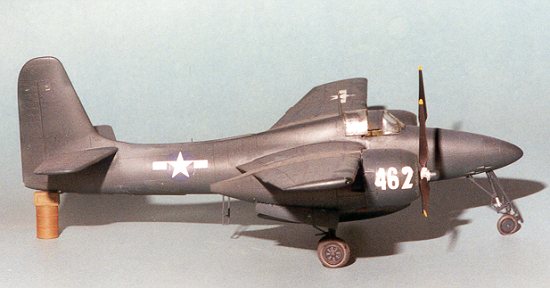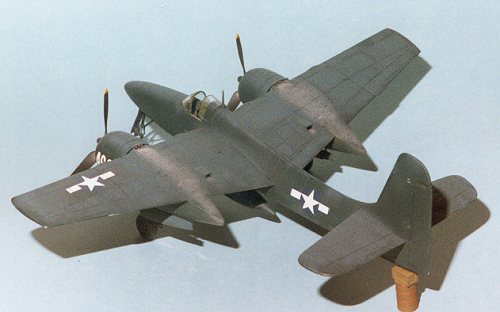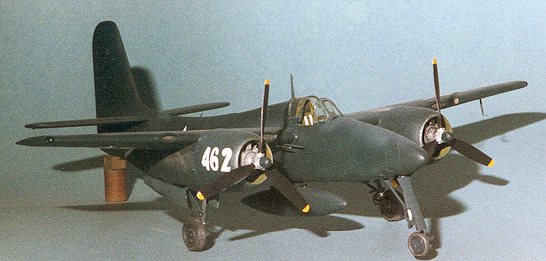
GRUMMAN F7F-3 "TIGERCAT"
Scale: 1/48
Suggested Retail Price: $18.50
Medium: Injected molded plastic, vinyl tires
Markings: 2 Marine Corps, 1 Navy--all in the overall sea blue schemes

 Third in the successful line of 'Cats built by Grumman primarily for the
Navy, the Tigercat was intended to be both a fleet interceptor and a long-range
attack aircraft. With two Pratt and Whitney R-2800 radials, the Tigercat
was fast at over 400 mph. Armed with four .50 caliber machine guns in the
nose and four 20mm cannon in the wing roots, it was also heavily armed. Used
as an attack aircraft, the F7F could carry either bombs or rockets. The first
operational group reached Okinawa the day World War II ended, so they saw
no action during World War II. Later models of the Tigercat saw service in
China before the Communist takeover, and in Korea during that war. Tigercats
served on in civilian livery into the 1970's as borate bombers fighting forest
fires in the Western U.S.
Third in the successful line of 'Cats built by Grumman primarily for the
Navy, the Tigercat was intended to be both a fleet interceptor and a long-range
attack aircraft. With two Pratt and Whitney R-2800 radials, the Tigercat
was fast at over 400 mph. Armed with four .50 caliber machine guns in the
nose and four 20mm cannon in the wing roots, it was also heavily armed. Used
as an attack aircraft, the F7F could carry either bombs or rockets. The first
operational group reached Okinawa the day World War II ended, so they saw
no action during World War II. Later models of the Tigercat saw service in
China before the Communist takeover, and in Korea during that war. Tigercats
served on in civilian livery into the 1970's as borate bombers fighting forest
fires in the Western U.S.
AMT/ERTL has nicely filled the gap in 1/48 scale between the Hellcat and the Bearcat with a well-detailed kit of the -3 model Tigercat. Other variants have followed and will continue to be released in the future. The only other kit in this scale I am aware of is the Classic Castings resin kit.
For your money you get a well molded kit with recessed panel lines. The kit's
plastic is a light gray color, a perfect base color for the overall sea blue
worn by most Tigercats.  The R-2800 engines are particularly well done. You
get both cylinder banks, the ignition harness, and the crankcase for each
engine. The front cylinder bank even has dimples on its front side in the
proper places where the spark plugs go, in case you decide to wire the engines.
The R-2800 engines are particularly well done. You
get both cylinder banks, the ignition harness, and the crankcase for each
engine. The front cylinder bank even has dimples on its front side in the
proper places where the spark plugs go, in case you decide to wire the engines.
The main complaint I have about the moldings is the number of mold release pin marks on the various kit parts, some in hard to reach places. Particular attention must be paid to the wheel wells in this regard. A minor complaint was the small amount of flash I found on some parts, particularly on some propeller blades. While I'm complaining, I should make mention of the fragile nature of the main gear. I opted not to put any weight in the nose of this model. Instead I will rely on the nicely detailed oil drum with the cartridge case on top to keep this notorious tail sitter on its gear. Although I thought this was a nice touch by the AMT/ERTL folks, I could have done with a sturdier gear.
Construction begins with the cockpit, as usual. The cockpit provided is a
nice one. I added seatbelts and a gunsight from Reheat Models, to dress it
up a bit. I painted my instrument panel scale black (very dark gray) all
over. After assembly, I saw pictures showing that Tigercats had the main
panel painted black with the column going to the floor painted interior green!
 Oh, well. The cockpit floor/nose gear well roof was warped a bit on my example.
A bead of super glue behind this part held it in its proper place.
Oh, well. The cockpit floor/nose gear well roof was warped a bit on my example.
A bead of super glue behind this part held it in its proper place.
The wings of Tigercats had a pronounced dihedral that is built into the kit's design, so don't attempt to "straighten" the wings. Parts fit was fair to excellent. Problem areas requiring filler included the wing to fuselage joints, the nacelles to wings joints, and a few spots here and there along the fuselage seam. I replaced the kit 20mm cannon with hypodermic tubing.
The canopy and windscreen have nicely done frame lines, easy to mask and paint. The decals were not as bad as I heard they were. To be on the safe side, I substituted some Superscale stars and bars at the usual four positions. Since I was doing an early Navy scheme, I used the kit decals for that version. A couple of applications of Solvaset made them snuggle down nicely. If you use the kit provided numbers for the sides of the engine nacelles, here's a tip. It comes with all three numbers on one decal. If applied like this, it can't hack the compound curves found on the nacelles. Cut the decals into individual numbers, then apply.
 If weathering is your bag, you can have a field day with this one. Like most
Navy and Marine Corps aircraft, the Tigercat saw long service periods under
harsh conditions. Most prominent on the Tigercat were the engine exhaust
stains on the nacelles and wings. I like to use a combination of gray and
brown pastel chalks to replicate this effect.
If weathering is your bag, you can have a field day with this one. Like most
Navy and Marine Corps aircraft, the Tigercat saw long service periods under
harsh conditions. Most prominent on the Tigercat were the engine exhaust
stains on the nacelles and wings. I like to use a combination of gray and
brown pastel chalks to replicate this effect.
Aside from the few problem areas I encountered, I enjoyed building this kit and would recommend it to anyone. I'm hoping to build a collection of Grumman 'Cats in 1/48 scale from the F4F "Wildcat" (Tamiya) to the F-14 "Tomcat" (Hasegawa). Now if I could only convince some manufacturer to release a GOOD quality kit of the F9F "Cougar" and the F11F "Tiger".
Review by Drew Nix